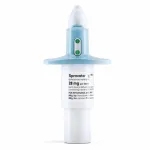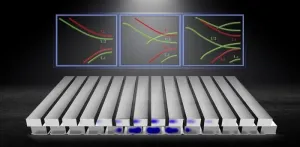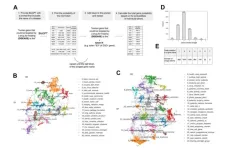(Press-News.org) Understanding Treatment-Resistant Depression
Treatment-resistant depression (TRD) is a particularly challenging form of major depressive disorder. As Albino Oliveira-Maia, head of the Champalimaud Foundation’s Neuropsychiatry Unit and the study’s national coordinator for Portugal, explains, “TRD is defined as the persistence of depressive symptoms despite adequate courses of at least two different antidepressant medications”. Despite repeated therapeutic attempts, these patients’ depressive symptoms remain.
Historically, TRD has posed a significant challenge. A study from the National Institute of Mental Health (NIMH) revealed that while a third of patients with depression found remission with their initial treatment, subsequent treatments saw diminishing returns, with only 10-15% attaining remission by their third trial. This stark reality amplifies the need for more effective intervention strategies.
Esketamine: Finding a Treatment for TRD
Janssen developed esketamine nasal spray, a formulation which has shown superior efficacy compared to placebo in several clinical trials. It has also secured approvals from the US Food and Drug Administration (FDA), in the US, and the European Medicines Agency (EMA), in Europe. But why is there a need for another drug in the already crowded antidepressant market, and another study on esketamine NS?
As Oliveira-Maia puts it, “While there are many treatments available for depression, there is a paucity of drug options tailored for TRD. Moreover, in order to guide clinicians and patients in their decision-making, and to be adopted by health insurance companies and governments, drug manufacturers need to demonstrate a distinct advantage over existing treatment modalities, underscoring the rationale for this study”.
Head-to-Head: Esketamine Versus Quetiapine
The study compared esketamine NS with oral quetiapine XR, an atypical antipsychotic originally authorised for conditions like schizophrenia but increasingly used, with regulatory approval , as an adjunctive treatment for difficult-to-treat episodes of depression. Oliveira-Maia notes, “Quetiapine is currently one of the few alternative medications approved as an add-on for patients with a major depressive episode and inadequate response to ongoing antidepressant treatment”.
Designed to mimic real-world conditions, the study was open-label, meaning both healthcare providers and patients were aware of the medications being used. Furthermore, given esketamine NS’s potential for acute dissociative effects, a double-blind approach was impractical. Importantly, however, efficacy assessments were conducted on site by independent raters who were blind to the trial group allocations. The multi-centre international study screened over 800 patients, of whom over 600 met the strict eligibility criteria for TRD and were subsequently included in the study.
Study participants were split into two cohorts: one self-administered quetiapine XR at home, while the other received esketamine NS under hospital supervision. Concurrently, both groups continued their most recent antidepressant regimen with a conventional antidepressant, either a selective serotonin reuptake inhibitor (SSRI, for example fluoxetine) or a serotonin and norepinephrine reuptake inhibitor (SNRI, for example venlafaxine). “The study spanned 32 weeks, which is longer than typical trials”, says Oliveira-Maia. “This allowed us to gauge both short-term and long-term treatment outcomes. Throughout this time, we closely monitored participants’ responses, side effects, and the medications’ overall efficacy”.
Oliveira-Maia elaborates, “We aimed to ascertain whether patients on esketamine NS were more likely to achieve remission— essentially corresponding to elimination of symptoms—by the eight-week mark, compared to those on quetiapine XR. Among those who achieved this remission at two months, we sought to determine the effects of continued treatment on preventing relapse in both arms up to the trial’s conclusion at 32 weeks”.
Unveiling the Findings
The results? After 8 weeks, both groups surpassed the 10-15% remission rate noted in the NIMH study, as published in the New England Journal of Medicine. Notably, 27.1% of patients on esketamine NS achieved remission, compared to 17.6% on quetiapine XR, with both groups continuing treatment with a conventional antidepressant (either an SSRI or SNRI). Long-term data was even more informative. The proportion of patients who achieved remission at week 8 and sustained it without relapse through week 32 was 21.7% for the esketamine NS group and 14.1% for the quetiapine XR group.
Most noteworthy for the authors was the marked uptick in remission rates after the initial eight-week initial period. As Oliveira-Maia remarked, “Had this trial concluded at eight weeks, the results would be quite interesting but not remarkable. However, the 32-week data tells a different story”. By this juncture, around half of the patients persisting with esketamine NS treatment - encompassing those not in remission by week eight - had achieved remission. In contrast, only a third of those continuing with quetiapine XR reached this state.
In addition to therapeutic efficacy, safety parameters were critically assessed. Both treatment options recorded very low rates of severe adverse events such as mortality or suicidal ideation. However, when examining less serious side effects, patients in the esketamine NS group presented a higher frequency compared to those in the quetiapine XR group. “This was anticipated, given esketamine’s dissociative properties,” says Oliveira-Maia. “Interestingly, the rate of patients discontinuing treatment due to side effects was actually lower for esketamine NS than for quetiapine XR, which suggests that while esketamine NS may have more side effects on paper, those caused by quetiapine were less tolerable”.
The Road Ahead: Clinical and Policy Implications
The findings are promising for patients grappling with TRD. Yet, as Oliveira-Maia points out, “The real challenge is shifting from research to policy. The impact of esketamine NS can only be realised if patients can readily access it”. At present, in Portugal and many other countries, there is limited access to approved, evidence-based treatments for TRD, including esketamine, but also electroconvulsive therapy and transcranial magnetic stimulation (TMS). “Continued research and strong advocacy are needed to make sure treatments reach the patients who need them”.
Looking forward, Oliveira-Maia remains optimistic. “Our future research endeavours aim to pinpoint predictive markers for treatment responsiveness. Additionally, we want to investigate ways to improve and sustain remission rates, including the potential role of psychotherapy. TMS is also high on our list for future exploration. However, scientific progress must be matched with proactive policy measures and concrete governmental action. Ultimately, our goal is to construct a healthcare landscape where patients are not relegated to subpar, non-evidence-based treatments due to lack of access to more effective options”.
END
Esketamine nasal spray: an option for patients with treatment-resistant depression
2023-10-04
ELSE PRESS RELEASES FROM THIS DATE:
Navigating moiré physics and photonics with band offset tuning
2023-10-04
When two lattices with distinct angles or periodicities come together, they conjure a moiré superlattice — a realm where astonishing phenomena like superconductivity and optical solitons spring to life. At the heart of this realm lies the moiré flatband, a key player in shaping advanced light–matter interactions, such as laser emission and second harmonic generation. In moiré physics and its relevant applications, wielding control over flatbands is a pivotal superpower.
Moiré flatbands are typically generated with special structures, often manipulated ...
Aging in place: U-M study highlights racial disparities among older adults
2023-10-04
Audio
Roughly 40% of older Black adults live with a disability, compared to only one-third of older adults overall.
Disability is one of various disparities highlighted in a new study from the University of Michigan, which used data from the National Poll on Healthy Aging to examine the extent to which 50- to 80-year-olds were prepared to age in place and the racial and ethnic disparities that exist to that end.
Sheria Robinson-Lane, U-M assistant professor of nursing and principal investigator, said many of the disparities were related to "weathering"—stressors connected to environmental, ...
U.S. drinking water often contains toxic contaminants, UNM scientist warns
2023-10-04
Most Americans take it for granted that the water that comes out of their taps is clean and safe to drink.
But a new study published by a University of New Mexico scientist with colleagues from across the U.S. warns that water from many wells and community water systems contains unsafe levels of toxic contaminants, exposing millions to health risks, including cancer.
The review in the Journal of Exposure Science and Environmental Epidemiology also finds that people living on tribal lands or ...
AI model for age-related disease target discovery
2023-10-04
“In this work, we focused on the application of the established pipeline to the identification of the potential targets related to aging [...]”
A new research paper was published in Aging (listed by MEDLINE/PubMed as "Aging (Albany NY)" and "Aging-US" by Web of Science) Volume 15, Issue 18, entitled, “Biomedical generative pre-trained based transformer language model for age-related disease target discovery.”
Target discovery is crucial for the development of innovative therapeutics and diagnostics. However, current approaches often face ...
Ruffed grouse population more resilient than expected, genetic study finds
2023-10-04
Despite decades of decline, a genetic analysis of ruffed grouse reveals that Pennsylvania’s state bird harbors more genetic diversity and connectivity than expected. The findings suggest that the iconic game bird could be maintained in persistent numbers if appropriate protections are implemented. The study, led by Penn State and Pennsylvania Game Commission researchers, published in the journal Molecular Ecology.
According to the researchers, Pennsylvania’s ruffed grouse populations have declined by up to 70% since the early ...
Ohio State awarded $20 million to put science behind tobacco product regulation
2023-10-04
The Ohio State University (OSU) has been awarded a $20 million Tobacco Center of Regulatory Science (TCORS) grant from the Food and Drug Administration’s (FDA) Center for Tobacco Products and National Institutes of Health.
The OSU-TCORS grant is a collaboration of experts from the colleges of medicine, public health and law organized and implemented through the Center for Tobacco Research at The Ohio State University Comprehensive Cancer Center – Arthur G. James Cancer Hospital and Richard J. Solove ...
Both high and low HDL cholesterol tied to increased risk of dementia
2023-10-04
EMBARGOED FOR RELEASE UNTIL 4 P.M. ET, WEDNESDAY, OCTOBER 4, 2023
MINNEAPOLIS – Having either high or low levels of high-density lipoprotein (HDL) cholesterol, or “good” cholesterol, is tied to a small increased risk of dementia in older adults, according to a study published in the October 4, 2023, online issue of Neurology®, the medical journal of the American Academy of Neurology. This study does not prove that high or low levels of HDL cholesterol cause dementia; it only shows an association.
“Previous studies on this topic have been ...
Meadow Spittlebug’s record-breaking diet also makes it top disease carrier for plants
2023-10-04
New research fueled in part by citizen scientists reveals that the meadow spittlebug—known for the foamy, spit-like urine released by its nymphs—can feed on at least 1,300 species of host plants, more than twice the number of any other insect.
The study, which is published today in the journal PLOS ONE, could be especially important in the effort to stop the bug from spreading a type of bacterium that has caused the death of crops across the world, including olive trees in Italy, grapevines in California, citrus trees in South America, and almond trees in Spain.
“Thirteen hundred host plants means 1,300 opportunities ...
Keshav Pingali to receive ACM-IEEE CS Ken Kennedy Award
2023-10-04
ACM, the Association for Computing Machinery, and IEEE Computer Society have named Keshav Pingali, the W.A.”Tex” Moncrief Chair of Grid and Distributed Computing at the University of Texas at Austin, as the recipient of the 2023 ACM-IEEE CS Ken Kennedy Award. The Ken Kennedy Award recognizes groundbreaking achievements in parallel and high performance computing. Pingali is cited for contributions to high-performance parallel computing for irregular algorithms such as graph algorithms. He is also cited for leadership on the Galois Project, which provides a unifying framework for parallelizing both irregular and regular algorithms.
Pingali has made deep and wide-ranging ...
Pandemic boosted gardening, hunting in NYS
2023-10-04
A survey of New York state residents found that nearly half of respondents increased the amount of time they spent on wild and backyard food in the early months of the COVID-19 pandemic, confirming anecdotes about increases in activities such as sourdough baking, fishing and gardening. People also tended to eat the food they produced, researchers found, possibly buffering the generally less healthful eating that was common at the time.
“This was the period of 2020 when you couldn't find tomato cages, seeds were out of stock, and there were reports about record numbers of people hunting and ...






